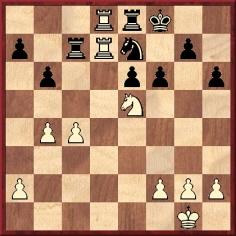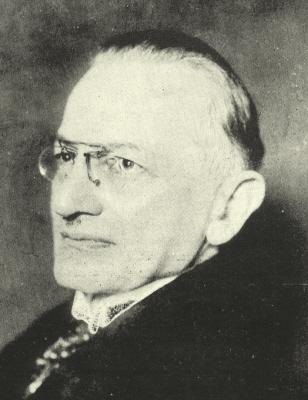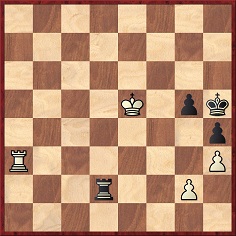
Edward Winter
Jud McCranie (Brunswick, GA, USA) asks who coined the remark ‘All rook endgames are drawn’. He has seen it attributed to both Tarrasch and Tartakower, but can a specific source be found?
At present we cannot resolve the matter. On pages 125-148 of his book on the 1908 world championship match Tarrasch wrote a treatise ‘Neue Untersuchungen über Turmendspiele’ which concluded with a remark that was only slightly similar:
‘Um ganz kurz zu resümieren, so scheint es, daß diese Endspiele in der Regel remis zu halten sind.’
The translation on page 487 of the November 1909 BCM was:
‘It appears that generally these endgames may be drawn.’
Naturally, Tarrasch was referring only to the type of rook endgames discussed in his treatise.
(5498)
From Ola Winfridsson (Cambridge, England):
‘I have found a passage that may shed some further light on the saying “All rook endgames are drawn”, although without nailing the quote as such. In the Göteborg, 1920 tournament book Rubinstein’s notes to the game A. Selesniev v S. Tartakower from round six of tournament A (the grandmaster group) included the following statement in a comprehensive comment on 29...Rc8 (see page 60):

“... Den av svart valda fortsättningen ser bra ut och leder till bondevinst, men därefter återstår blott remisfigurerna, tornen, då en bonde mer sällan räcker till vinst ...” [“... The continuation chosen by Black looks convincing and leads to the win of a pawn. However, this leaves only the drawing pieces, the rooks, when an extra pawn is seldom enough to win ...”]
This would seem to indicate that it was a generally accepted piece of chess wisdom among the leading grandmasters (Tarrasch, Tartakower and now Rubinstein) at the time that rook endings were notoriously drawish in character.’
(5585)
Information is still being sought on who (e.g. Tarrasch or Tartakower) coined the phrase ‘All rook endgames are drawn’. Mark Donlan (Harwich, MA, USA) quotes from page 166 of Profile of a Prodigy by Frank Brady (New York, 1973) concerning the tournament in Rovinj-Zagreb, 1970:
‘When Fischer played against Petrosian in the final round, the Armenian secured an opening advantage, but Fischer dominated the rook ending. Petrosian said later that he remembered Tartakower’s statement that “all rook endgames are drawn”, and the thought comforted him.’
(5726)
From page 105 of Das Schachspiel by Siegbert Tarrasch (Berlin, 1931):
‘Im Turmendspiel hat die schwächere Partei meist bis zum Schluß Remischancen.’
The English translation on page 81 of The Game of Chess (London, 1935) read:
‘In rook endings the weaker side generally has some chances of a draw right up to the very end.’

Siegbert Tarrasch
(5822)
Christian Sánchez (Rosario, Argentina) notes that page 108 of El Ajedrez Americano, April 1931 ascribed to Tartakower the following remark in the transcript of a lecture in Buenos Aires on 6 April 1931:
‘Al contrario que en los finales de peones solos contra peones, en el final de torres y peones contra torre y peones, la ventaja gana casi siempre.’
Our correspondent adds that this assertion (that a material advantage will nearly always win in rook endings, but not in pawn endings) was the opposite of what Tartakower had said. He asked for a correction to be published, and on page 130 of the May 1932 [sic] issue Roberto Grau wrote concerning Tartakower:
‘Afirmó que en el final de torre y peones contra torre y peones pasa todo lo contrario que en el final de peones solos, ya que “la pequeña ventaja material se neutraliza casi siempre”. (En el artículo anterior se deslizó un error tipográfico y se dijo todo lo contrario. El Dr Tartakower nos pidió oportunamente la rectificación que ahora publicamos.)’
(10012)
On page 46 of the January 1997 Chess Life an article entitled ‘Erroneous Transition to the Pawn Endgame’ by Lev Alburt and Leonid Verkhovsky with Leo Dykhno referred to a ‘diction’:

Citations for the dictum ‘the rook endgames are never won’ are sought. On page 86 of The Wisest Things Ever Said About Chess (London, 2008) Andrew Soltis referred to ...
‘... Tarrasch’s more sweeping claim that “rook and pawn endings are never won”. (A minority credits a version of this to Tartakower.)’
Page 240 of Turning Advantage Into Victory in Chess by Soltis (New York, 2004) had this:

(11634)
From W.D. Rubinstein (Victoria, Australia):
‘Why is it that endings where one side has two rooks are seldom or never covered (e.g. in the Batsford series by Averbakh et al.)? Indeed, if one side still has two rooks, is it an endgame?’
Surely it is. And a very common one; glancing at the Weltgeschichte des Schachs volume on Capablanca we note that he had more 2R v 2R endings to play than, for instance, QvQ, NvN, etc. Yet it is true that literature neglects them. Pachman, in his Chess Endings for the Practical Player, also fails to give a single specimen. Is one to assume that the principles involved are identical as those for RvR? No, there must be more to it than that.
(716)
If the books neglect the two-rook ending, what about magazine articles? We have so far found just two, by Rinck, in the February and June 1921 issues of La Stratégie.
(817)
Pat Constant (Cork, Ireland) draws our attention to an article on double rook endgames in the October 1980 CHESS, by Edmar Mednis (pages 277-280).
(842)
A subsequent book was mentioned in a footnote on page 169 of Kings, Commoners and Knaves: Batsford Chess Endings provided coverage of the two-rook ending on pages 324-332.
‘Rook endings a pawn up are generally drawn – but rook endings a pawn down are usually lost.’ (J.J. Walsh.) See C.N. 775 in Chess Jottings.

Guinet-Chataing, Lyons, 1890
1 Ra8 Rxg2 and White announced mate in six moves (2 Kf6 Rf2+ 3 Kg7, etc.)
Source: La Stratégie, 15 October 1890, page 328.
(Kingpin, 2000)
To the Chess Notes main page.
To the Archives for other feature articles.
Copyright: Edward Winter. All rights reserved.